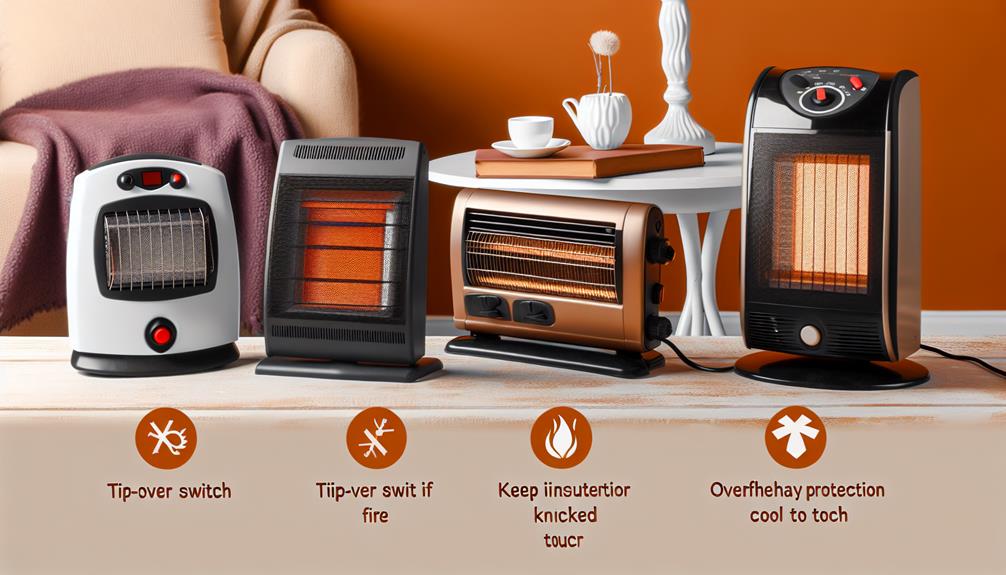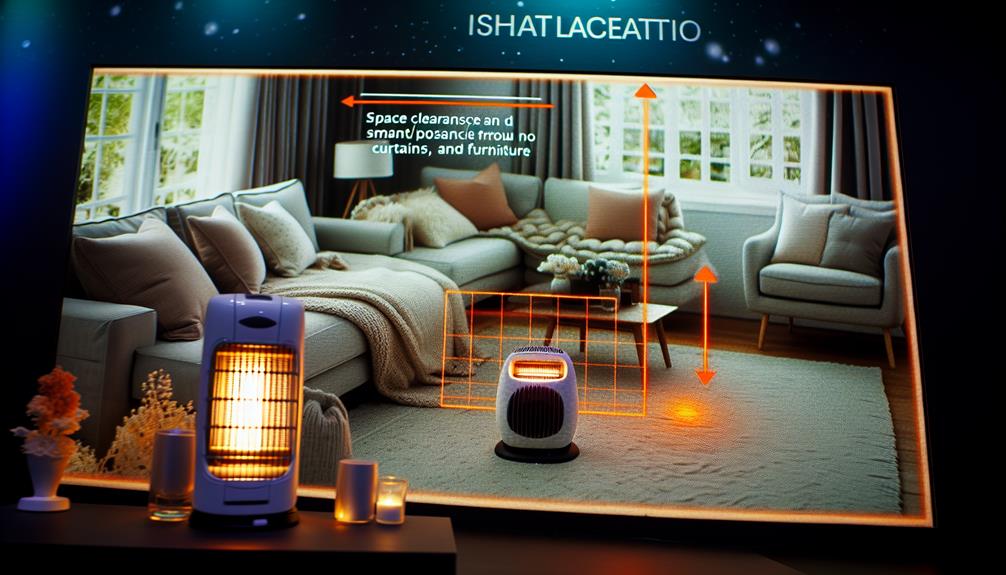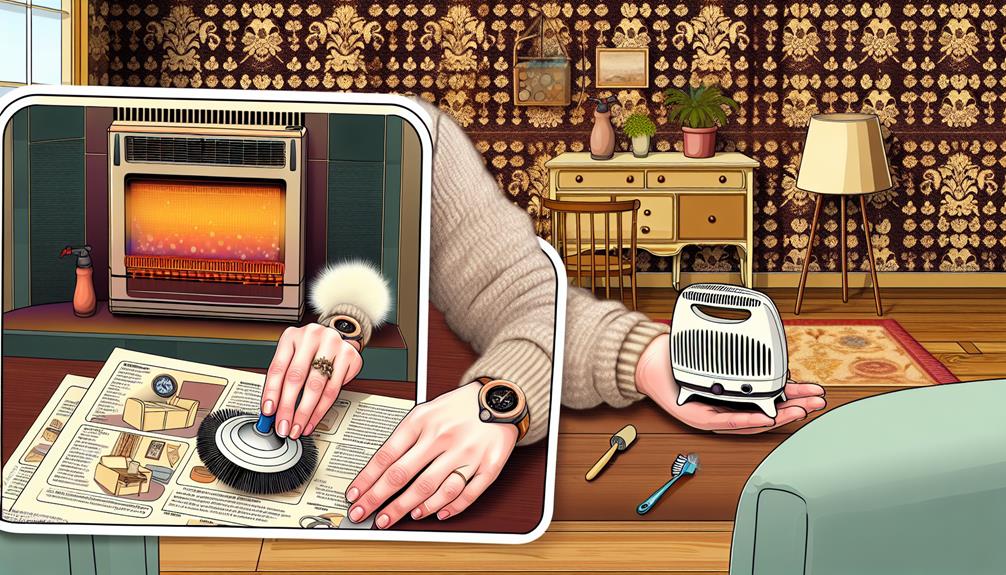Nearly 40% of homeowners are unaware of the energy efficiency ratings of their space heaters, potentially leading to higher electricity bills and a less than optimal heating experience. As you consider adding a portable heater to your home or office, understanding the key factors that contribute to a smart purchase is crucial. You'll want to evaluate the size of the space you're looking to heat, the type of heater that suits your needs, and the safety features that ensure your peace of mind. Whether you're interested in the gentle warmth of a radiant heater or the consistent flow of a convection unit, the choices can be overwhelming. With an array of options varying in power, design, and technology, finding the right fit isn't just about plugging in a device and hoping for the best. It's about making an informed decision that balances comfort, cost, and efficiency. In the following sections, we'll guide you through the essentials of selecting a portable heater that not only meets your expectations but also enhances your living or working environment.
Key Takeaways
- Evaluate room size, desired features, and budget constraints when assessing your heating needs.
- Consider the type of heater that best suits your space, such as oil-filled radiators, ceramic and infrared heaters, convection heaters, or radiant heaters.
- Prioritize adjustable heat settings and programmable thermostats for temperature control and energy savings.
- Ensure the heater has safety features like overheat protection and tip-over switch, and look for models certified by recognized testing laboratories like Underwriters Laboratories (UL).
Assessing Your Heating Needs
Before investing in a portable heater, you'll need to evaluate your specific heating requirements, including room size, desired features, and budget constraints. To maintain an optimal room temperature, you must choose the type of heater best suited to your space. As you delve into space heater buying, consider the heating element and its efficiency, as some may lead to higher energy consumption than others. Infrared and oil-filled heaters, for instance, offer different heat distribution patterns and might serve as effective supplemental heat sources depending on the area you wish to warm.
When it comes to features, look for a heater with adjustable heat settings that allow for precise temperature control. A programmable thermostat can contribute to energy savings by automatically maintaining the desired temperature. Additionally, prioritize safety features in your portable heater. Overheat protection ensures the unit shuts off if it becomes too hot, and a tip-over switch is vital for preventing accidents. Don't overlook the importance of safety certification from recognized testing laboratories, which confirms that the heater meets rigorous safety standards. Remember, the right balance between performance, energy consumption, and safety will lead you to the optimal portable heater for your needs.
Types of Portable Heaters
When selecting a portable heater, you'll encounter various technologies, each with its own energy efficiency profile. Oil-filled radiators provide consistent heat and are typically more energy-efficient for prolonged use, whereas ceramic and infrared heaters offer rapid spot heating with less energy retention. It's essential to match the heater's wattage to your room size, taking into account ceiling height and insulation, to ensure optimal performance and energy consumption.
Heater Technology Varieties
Understanding the different technologies behind portable heaters—convection, radiant, and fan-forced—is key to selecting the right device for your specific heating needs. Here's a breakdown:
- Convection Heaters: These heaters use convection to warm and circulate air within your space. They're ideal for evenly distributing heat and often come with a thermostat to manage the heat setting, ensuring consistent heating performance.
- Radiant Heaters: These units emit radiant heat to provide supplemental heat directly to objects and people, rather than heating the air. They're perfect for spot heating and typically offer quick comfort with less energy.
- Fan-Forced Heaters: By using a fan, these electric heaters distribute heat more rapidly across larger areas. They generally have multiple heat settings and heater safety features, including safety certification, to protect against overheating or tip-overs.
Energy Efficiency Considerations
While selecting a portable heater based on technology is crucial, it's equally important to consider the energy efficiency of each type to optimize your heating costs and environmental impact. Convection heaters, while distributing heat through air movement, may consume more electric power over time compared to radiant heaters, which deliver heat more directly and swiftly. Pay attention to the amount of energy a heater consumes; those designed for standard home and office use typically plug into 120-volt 15-amp receptacles.
To reduce the cost of operating your heater, look for models with an onboard thermostat or thermostat dial, allowing for precise temperature settings. The Department of Energy suggests that energy-efficient portable heaters can significantly lower your energy bills and maintain a comfortable heat output without wasting excess energy.
Heater Safety Features

Your portable heater's safety is paramount, so ensure it includes crucial features such as an overheat protection switch and tip-over protection switch to mitigate fire risks. These features are designed to automatically shut off the heater if it gets too hot or if it's knocked over—an essential aspect for preventing potential fires. Moreover, it's vital that your heater is certified by a recognized testing laboratory, such as Underwriters Laboratories (UL), affirming that it meets the stringent safety standards set by the National Fire Protection Association (NFPA).
When selecting a heater, remember these added safety features:
- Overheat Protection: This function cuts power if internal components reach unsafe temperatures, preventing the unit from becoming dangerously hot to the touch.
- Tip-Over Protection: A protection switch that instantly turns the heater off if it tips over, reducing the risk of fire if you accidentally knock it or leave the room.
- Cool-to-the-Touch Exteriors: To ensure added safety, especially in households with children or pets, look for models that remain cool during operation.
Never leave your heater unattended, and avoid using it on soft surfaces where it's more likely to tip. Always place your heater on a flat, stable surface and inspect the cord regularly for any signs of damage.
Energy Efficiency and Cost
After ensuring your portable heater has the necessary safety features, it's important to consider its energy efficiency and the potential impact on your utility bills. Portable heaters are rated in British thermal units per hour (BtuH), which indicates the amount of heat they can distribute. Some heaters also offer wattage or kilowatt ratings, allowing for a direct comparison with your electric heating system.
Heaters tend to vary in energy efficiency, with electric models typically using 120-volt 15-amp receptacles. When you use the heater, the operating cost hinges on its wattage, the local per-hour rate for electricity, and how long the heater runs. To reduce the risk of high utility bills, look for heaters with higher BtuH ratings that distribute more heat around your space without needing to work as hard.
Combustion heaters, which can be fueled by gas, oil, or kerosene, usually cost less to operate than their electric counterparts. However, they require adequate ventilation to prevent the build-up of harmful gases like carbon monoxide and nitrogen dioxide. Choosing an energy-efficient portable heater can help manage costs while ensuring your space remains comfortably warm.
Heater Placement Considerations

Determining the optimal placement for your portable heater requires careful consideration of the room's size and layout to ensure effective and safe heating. Heater placement considerations are key to maximizing comfort while minimizing risks. Here's what you need to keep in mind:
- Surface and Stability: Place your heater on a hard, level, nonflammable surface. It's vital to ensure the heater is stable to prevent it from tipping over, which could lead to accidents.
- Clearance for Safety: Establish a safety perimeter. Keep at least a 3-foot distance from combustible materials and maintain a kid- and pet-free zone around the heater.
- Appropriate Distance: Position your heater to disperse heat effectively. For a small area or personal space, direct the heat where you need it most. In a large space, strategically place the heater to disperse heat throughout the entire room.
Never mount a portable heater on the wall unless it's designed for it. Avoid running the heater with an extension cord, as this can be a fire hazard. By following these guidelines, you'll enjoy a cozy, warm environment that's also safe and efficient.
Brand and Model Comparisons
When selecting a portable heater, comparing brands like DeLonghi, Honeywell, and Lasko, alongside specific models such as the Vornado VH200 and Lasko 754200 Ceramic Heater, becomes crucial to balance features, pricing, and energy efficiency for your heating needs. The Vornado Vheat, with its vintage design, offers a unique blend of form and function, utilizing vortex air circulation to heat rooms evenly. For a more contemporary look, the Ceramic Heater range, including the Lasko 754200, provides quick heating with lower energy consumption, suitable for small to medium-sized spaces.
Models like the DeLonghi TRD40615T excel in creating sustained radiant heat, ideal for maintaining a consistent temperature over several hours. These units often cover larger square feet areas and may include features like a remote control for convenience. The Vornado AVH10, recognized as one of the best space heaters, combines an auto climate control system with a whisper-quiet operation, positioning it as one of the quietest space heaters available.
For a budget-friendly option, Amazon Basics heaters provide essential functions without the premium price, while the Heat Storm brand offers powerful portable solutions with innovative Wi-Fi capabilities. Always check the wattage and energy efficiency ratings to ensure your heater needs are met without inflating your utility bills.
Maintenance and Care Tips

To keep your portable heater in top condition, establish a regular cleaning routine that includes inspecting the power cord and clearing vents of dust. You'll want to ensure safety features are operational, verifying that automatic shut-offs and tip-over switches function without fail. Always adhere to the manufacturer's specific maintenance recommendations to safeguard both performance and longevity.
Regular Cleaning Routine
Keep your portable heater running efficiently by establishing a routine to regularly clean away any dust and debris that can accumulate on both the exterior and interior components. This not only ensures your new space heater functions at its best, but it also contributes to better air quality in your room.
To maintain your heat source optimally:
- Unplug the heater, let it cool, then gently wipe the exterior with a soft cloth to prevent dust layers that can impede warm air flow.
- Vacuum or use a brush attachment to clear the air intake and exhaust vents, safeguarding against blockages that compromise heating efficiency and indoor air circulation.
- Inspect the power cord for wear; a compromised cord poses a risk and should be replaced to maintain safe operation of your heaters.
Safe Operation Practices
Building on the foundation of a clean heater, it's crucial to adopt safe operation practices to ensure your portable heater not only runs efficiently but also remains a safe addition to your home. Always place your space heater on a hard, level, nonflammable surface. For added safety, maintain a 3-foot clearance from children, pets, and combustible materials—this helps prevent accidents and ensures that the heater will best warm a room without risks. To keep you warm safely, never leave the heater on when you exit the room or while sleeping. Regularly inspect the power cord for wear and tear, and avoid using extension cords, which can overheat. If your heater shows signs of damage, consider it a clear signal to replace the unit to maintain optimal safety and heating efficiency.
Additional Heater Accessories
Enhancing your heater's functionality with accessories like a programmable thermostat can provide you with precise temperature management, ensuring both comfort and energy efficiency. When you're in the market for a space heater, consider these additional accessories to optimize your heating experience:
- Programmable Thermostat: This accessory allows you to set specific temperatures for different times of the day or night. It's perfect for maintaining a consistent temperature without having to manually adjust the heater, saving you money by heating up the air only when necessary.
- Remote Control: Many modern space heaters come with a remote to adjust settings from across the room. Whether you're looking for the ease of switching between low and high settings or just want to turn the heater on or off without getting up, a remote control offers that added convenience.
- Safety Features: Look for heaters that include a tip-over switch or overheat protection for added safety. Some models also use fans to distribute the heat more evenly, which can prevent overheating in one area.
Frequently Asked Questions
How Do I Choose a Portable Space Heater?
Navigating the sea of portable heaters, you'll want to chart a course for energy efficiency and heater types that match your room's size. Prioritize safety features and a whisper-quiet operation to keep your peace undisturbed. Pick a unit with thermostat control for precise warmth, and consider design aesthetics that complement your space. Weigh cost against expected maintenance and sift through user reviews for real-world performance insights. Your ideal warmth companion awaits discovery.
How Do I Know What Size Space Heater I Need?
To determine the size space heater you need, assess the heating capacity required for your room's square footage and insulation quality. Consider energy efficiency, how often you'll use it, and the heater type that suits your climate. Safety features are crucial, as are noise levels if you're sensitive to sound. Maintenance needs and the power source are also key factors in your decision. Choose wisely for a comfortable, safe environment.
How Do I Know What Size Heater I Need?
You're freezing, yet you think any old heater will do? Think again! For optimal heater efficiency, match heating capacity to your room size. Prioritize energy source compatibility, and don't overlook safety features. Climate consideration is key; don't buy a weak heater if you're in the tundra. Ensure low noise levels for peace, and seek convenient timer functions. Heater placement matters for even warmth. Fancy a chic look? Check design aesthetics and don't ignore maintenance requirements.
What Is the 3 Foot Rule for Space Heaters?
The 3-foot rule for space heaters is a safety distance ensuring heater placement allows for furniture clearance and avoids flammable objects. It's crucial for effective heat distribution and minimizes fire risks. Ensure the heater's cord reach doesn't necessitate stretching across walkways. This rule also considers child safety, pet considerations, and maintaining enough space for ventilation requirements and routine maintenance. Always respect this boundary to safeguard your space and loved ones.
